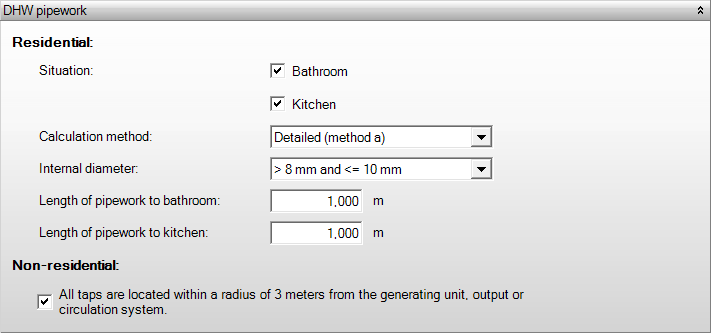Domestic Hot Water
The template ‘domestic hot water’ contains all characteristics to provide domestic hot water to residential and non-residential buildings. The complete concept of generation, distribution, and emission are assigned to the rooms within the building in this template. The data regarding emission and potential shower heat recovery, including references to the distribution and generation, is specified in the domestic hot water template.
Water distribution
The distribution network, to which the emission of domestic hot water is connected, is indicated here. In the distribution it can be specified whether a circulation system for domestic hot water is applied. The generation configuration can be specified in the distribution as well.
DHW pipework
Situation
- EPG
In housing, it can be specified whether the tap water system is applied to the bathroom and/or the kitchen. This means that 1 or 2 domestic hot water systems are defined within the house. A system needs to be specified for both the bathroom and the kitchen in housing. Example: a combi-boiler which delivers hot water to both the bathroom and the kitchen, or one boiler delivering hot water to the bathroom and an electric water heater delivering hot water to the kitchen.
Publications
Determination of Energy Use for Domestic Hot Water – Calculation Values – Residential Category
Calculation method
- EPG
The method to determine the emission efficiency for domestic hot water systems in a residential building is indicated here. Method b is a simple method which uses fixed emission efficiencies, whereas method A is more elaborate as the emission efficiency is determined based on the centre line of tap water pipes and the length of the pipelines to the bathroom and kitchen.
- Simple (method B), simple method with fixed efficiencies. It is only required to specify the internal diameter of the pipelines to the kitchen.
- Detailed (method A), extended method. In addition to the internal diameter of the tap water pipes to the kitchen, also the length of the tap water pipes to the kitchen and the bathroom are required.
Publications
Calculation Values for Delivery Efficiency
Internal diameter
- EPG
The internal diameter of the tap water pipes to the kitchen can be specified here. This diameter is used to determine the emission efficiency for both the simple and the detailed method.
- <= 8 mm, the internal diameter of the tap water pipes is not greater than 8 mm on at least 2/3 of the length of the pipes;
- > 8 mm and <= 10 mm, the internal diameter of the tap water pipes is greater than 8 mm and not greater than 10 mm on at least 2/3 of the length of the pipes;
- > 10 mm, the internal diameter of the tap water pipes is greater than 10 mm on at least 2/3 of the length of the pipes.
Length of pipework to bathroom
- EPG
The length of tap water piping to the bathroom is specified here in m. This is only required if the detailed calculation method is applied.
Length of pipework to kitchen
- EPG
The length of tap water piping to the kitchen is specified here in m. This is only required if the detailed calculation method is applied.
All taps are located within a radius of 3 metres from the generating unit, output, or circulation system
- EPG
For utility buildings it should be indicated whether the average length of the tap water pipes is more or less than 3 m. The length of the pipes is measured from the generation unit, circulation system, or delivery set to the tap.
Publications
Calculation Values for Delivery Efficiency
Shower Heat
Heat recovery from shower water
- EPG
Checking this box indicates heat is recovered from shower water. The recovered heat is applied to heat up drinking water, to use at the cold gate of a mixer tap, or at the inlet of the unit for hot water preparation.
Custom efficiency
- EPG
By default, the efficiency of the heat recovery of shower water is determined flat rate. By specifying a custom efficiency one can deviate from this method. Doing so requires a quality statement to be discussed.
Connected to
- EPG
A correction factor for the thermal efficiency is determined based on the connection of the shower heat recovery system.
- Cold gate of the shower mixer: an individual shower heat recovery system is connected to the cold gate of the shower mixer.
- Inlet of the heater: an individual shower heat recovery system is connected to the inlet of the heater.
- Cold gate of the shower mixer and inlet of the heater: an individual shower heat recovery system is connected to both the cold gate of the shower mixer and the inlet of the heater.
- Collective arrangement: various shower heat recovery system are arranged collectively.
Publications
Calculation Values for Delivery Efficiency

